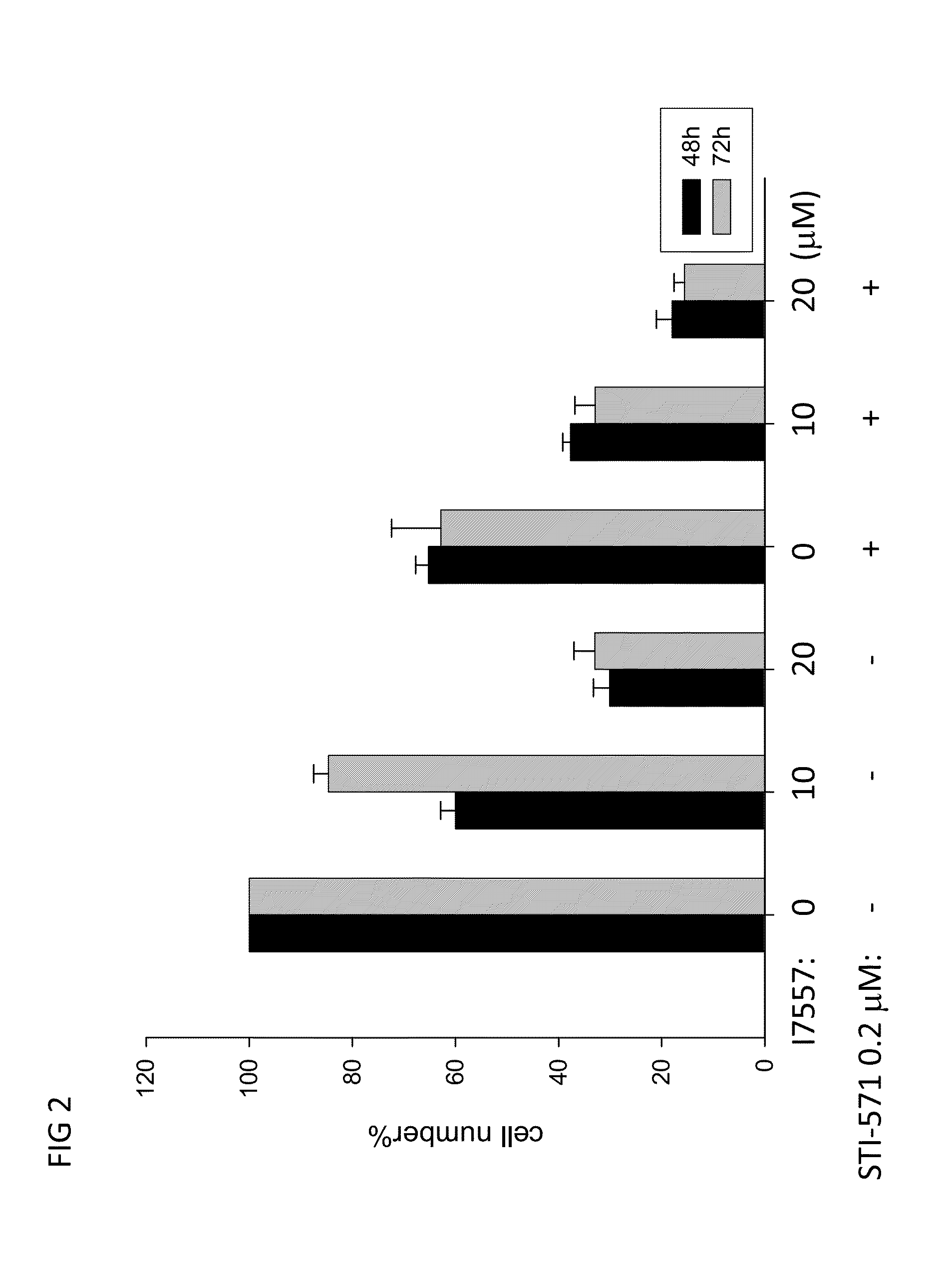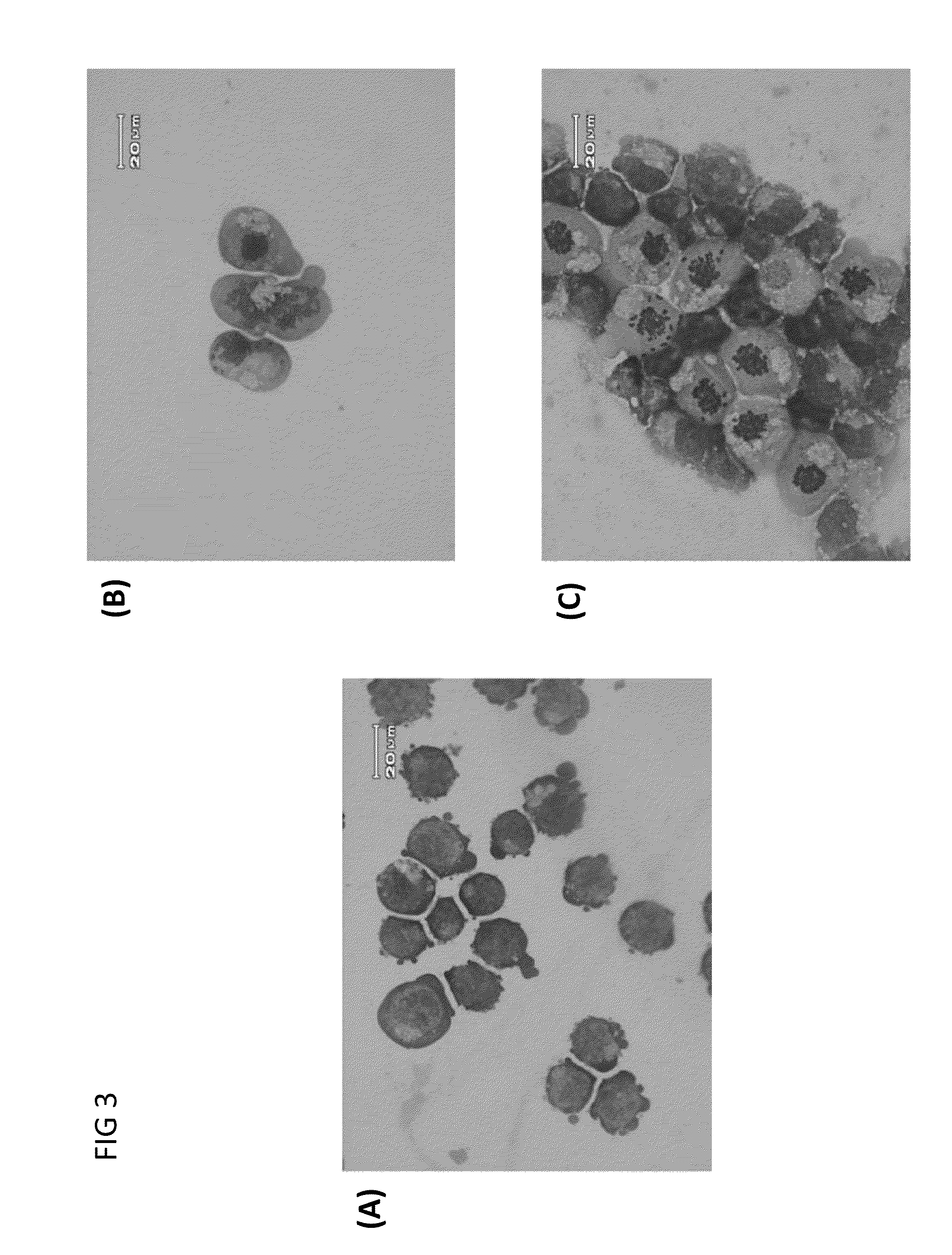Novel use of isothiocyanates for treating cancer
a technology of isothiocyanates and cancer, applied in the direction of biocide, organic chemistry, drug compositions, etc., can solve the problems of limiting its effectiveness, rendering these drugs(s) useless for cancer treatment, and cancer has become the major cause of death, so as to improve the treatment of cancer
- Summary
- Abstract
- Description
- Claims
- Application Information
AI Technical Summary
Benefits of technology
Problems solved by technology
Method used
Image
Examples
example 1
I7457 and I7557 Inhibit the Growth of Drug Resistant CML K562R Cells
[0066]The imatinib resistant human chronic myelogenous leukemia (CML) cell line K562R was induced by procedures described above in the “Materials and Methods” Section. Anti-proliferative activity of I7557 and I7557 were respectively assessed by cell viability and cell cycle analysis, as well as by immunoblot and Liu's Staining.
[0067]FIGS. 1 and 2 illustrate the effects of I7457 and I7557 on cell viability of imatinib resistant CML cells respectively. It is evident that both I7457 and I7557 are effective in reducing the cell number in a dose dependent manner; and drug resistant CML cell number is reduced to at least 65% of that of the control in the presence of 20 μM of the tested compound.
[0068]Cell cycle analysis further indicated that at least 60% of the CML cells are arrested at G2 / M phase, with the population of cells in sub-G1 group increases with an increase in the dosage of I7457 or I7557 (see Table 1).
TABLE ...
example 2
I7457 and I7557 Inhibit the Growth of Human Pancreatic Carcinoma, Epithelial-Like Cell Line PANC-1
[0072]Effects of the compounds of this disclosure, I7457 and I7557 on PANC-1 cells were investigated in accordance with similar procedures described in Example 1, including cell viability assay, cell cycle analysis, immunoblot analysis on the expression of the cell cycle associated proteins, and morphology analysis.
[0073]Cell viability assay indicated that both I7457 and I7557, at the concentration of 20 μM, were effective in reducing the cancerous cell number by at least 50%, as compared with that of the control cells (data not shown). Cell cycle analysis revealed that treatment with I7457 and I7557 for merely 24 hours can arrest at lest 50% of the cells at G2 / M phase, with the population of cells in sub-G1 group increases with an increase in the dosage of I7457 or I7557 (see Table 2). As to cell cycle associated proteins, their expression pattern were similar to those observed in drug...
example 3
I7457 and I7557 Enhance the Susceptibility of Human Pancreatic Cancer Cells to Radiation Treatment
[0074]In this example, effects of I7457 and I7557 on the susceptibility of human pancreatic cancer cell lines Panc-1 and BxPc-3 to radiation were investigated.
[0075]To this purpose, cancerous cells were pre-treated with I7457 or I7557, before being treated with various doses of radiation in accordance with procedures described in “Materials and Methods” section. The survived cells were then subject to clonogenic assay, which is a test generally employed to determine the effect of drugs or radiation on the cells' ability to undergo unlimited division by counting the number of colony formed from a single cell. The colony is defined to consist of at least 50 cells. Results are presented in Tables 3 and 4. Both compounds of this invention, i.e., I7457 and I7557, at dose of 10 μM, are capable of enhancing the susceptibility of PANC-1 and BxPc-3 cells to radiation treatment; hence these compo...
PUM
| Property | Measurement | Unit |
|---|---|---|
| Fraction | aaaaa | aaaaa |
| Fraction | aaaaa | aaaaa |
| Fraction | aaaaa | aaaaa |
Abstract
Description
Claims
Application Information
 Login to View More
Login to View More - R&D
- Intellectual Property
- Life Sciences
- Materials
- Tech Scout
- Unparalleled Data Quality
- Higher Quality Content
- 60% Fewer Hallucinations
Browse by: Latest US Patents, China's latest patents, Technical Efficacy Thesaurus, Application Domain, Technology Topic, Popular Technical Reports.
© 2025 PatSnap. All rights reserved.Legal|Privacy policy|Modern Slavery Act Transparency Statement|Sitemap|About US| Contact US: help@patsnap.com



